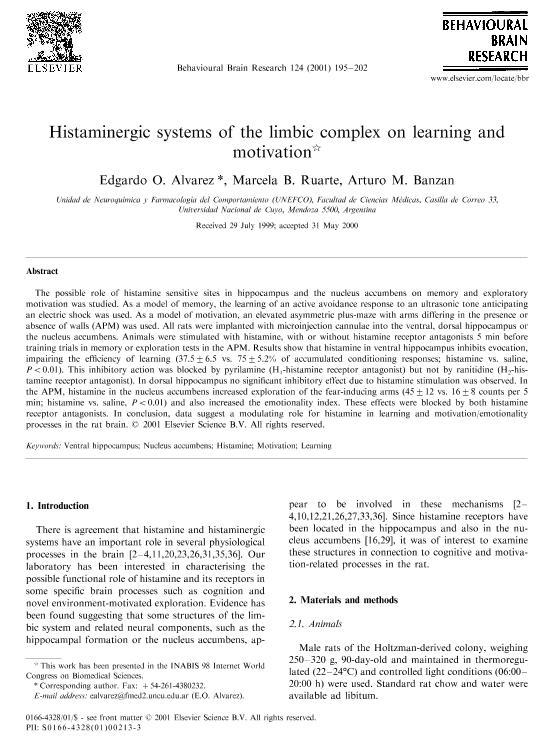Artículo
Histaminergic systems of the limbic complex on learning and motivation
Fecha de publicación:
10/2001
Editorial:
Elsevier Science
Revista:
Behavioural Brain Research
ISSN:
0166-4328
Idioma:
Inglés
Tipo de recurso:
Artículo publicado
Clasificación temática:
Resumen
The possible role of histamine sensitive sites in hippocampus and the nucleus accumbens on memory and exploratory motivation was studied. As a model of memory, the learning of an active avoidance response to an ultrasonic tone anticipating an electric shock was used. As a model of motivation, an elevated asymmetric plus-maze with arms differing in the presence or absence of walls (APM) was used. All rats were implanted with microinjection cannulae into the ventral, dorsal hippocampus or the nucleus accumbens. Animals were stimulated with histamine, with or without histamine receptor antagonists 5 min before training trials in memory or exploration tests in the APM. Results show that histamine in ventral hippocampus inhibits evocation, impairing the efficiency of learning (37.5 ± 6.5 vs. 75 ± 5.2% of accumulated conditioning responses; histamine vs. saline, P < 0.01). This inhibitory action was blocked by pyrilamine (H1-histamine receptor antagonist) but not by ranitidine (H2-histamine receptor antagonist). In dorsal hippocampus no significant inhibitory effect due to histamine stimulation was observed. In the APM, histamine in the nucleus accumbens increased exploration of the fear-inducing arms (45 ± 12 vs. 16 ± 8 counts per 5 min; histamine vs. saline, P < 0.01) and also increased the emotionality index. These effects were blocked by both histamine receptor antagonists. In conclusion, data suggest a modulating role for histamine in learning and motivation/emotionality processes in the rat brain.
Palabras clave:
HISTAMINE
,
LEARNING
,
MOTIVATION
,
NUCLEUS ACCUMBENS
,
VENTRAL HIPPOCAMPUS
Archivos asociados
Licencia
Identificadores
Colecciones
Articulos(IMBECU)
Articulos de INST. DE MEDICINA Y BIO. EXP. DE CUYO
Articulos de INST. DE MEDICINA Y BIO. EXP. DE CUYO
Citación
Alvarez, Edgardo O.; Ruarte, Marcela B.; Banzan, Arturo Martin; Histaminergic systems of the limbic complex on learning and motivation; Elsevier Science; Behavioural Brain Research; 124; 2; 10-2001; 195-202
Compartir
Altmétricas




